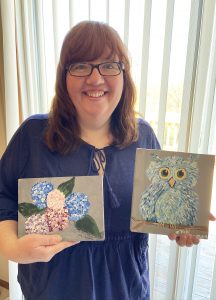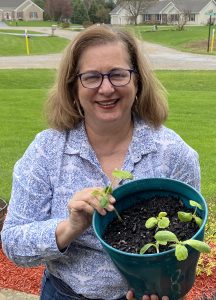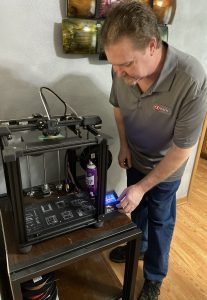Cultivate new interests, be creative and lower anxiety while stuck at home
By Lynne Conner For Chronicle Media — May 22, 2020

Vicki Sherman of Machesny Park show off some of her acrylic on wood paintings. (Photo by Lynne Conner / for Chronicle Media)
Feeling creative, energized, fulfilled and optimistic during these uncertain days of the COIVD-19 pandemic, may seem impossible if not for hobbies and recreational pursuits.
As the community follows the stay-at-home directive, many residents have more time to indulge in their hobbies due to altered work schedules and a reduction in most social events.
Jena Webber, a massage therapist who lives in southwestern Winnebago County, has recently taken up growing organic vegetables in part to get ahead on her summer garden.
“I knew that some vegetables with ‘roots and shoots’ could be ‘recycled’ to grow new plants, so I watched YouTube videos online and discovered that there’s a whole host of vegetables that you can grow from existing vegetables,” she said.
“I was able to get seed potatoes, but regular grocery store organic potatoes should work for starting new plants. I took cut up sections of these potatoes with a few ‘eyes’ on them, dried them out and planted them.”
Webber also started onion plants from existing onion roots that she cultivated in water before planting in soil.
For her tomato and pumpkin plants, Webber ordered seeds online and started growing them outdoors in vintage washtubs.
“I chose the washtubs for the capacity and because I can move them to the garage if there’s frost. Many online seed stores were sold out and I think that’s because more people ordered seeds online this year since many gardening centers were closed due to COVID-19,” she said.
Webber recommends two YouTube videos as a tutorial on growing vegetables, “14 Store Bought Vegetables & Herbs You Can Regrow” and “15 Fastest Growing Survival Vegetables to Grow in a Crisis”.
“I’m not an expert gardener by any means,” Webber said. “I just watched the videos, learned from YouTube and planted the vegetables that looked interesting to grow. I can’t wait to see how these plants transfer to my summer garden.”
For Vicki Sherman of Machesney Park, picking up a brush and revisiting her hobby of painting has helped this pre-school teacher deal with the disappointment of a school year cut short.

Jena Webber of Rockford shows off a potato plant she started from a cut potato. (Photo by Lynne Conner / for Chronicle Media)
“I really liked to sketch, draw and paint when I was a kid, but I got out of the habit until one of my Facebook friends started doing online tutorials on how to paint. I thought it looked like a fun thing to do and it definitely gives me something to enjoy and helps me relax,” she said.
Sherman mostly uses acrylic paints and choses either wood or canvas as her medium. She has completed five paintings to date.
“I actually re-did the first painting because I wasn’t 100 percent satisfied with how it turned out,” she said. “I discovered that my paintings turn out better if I watch the tutorial first, then watch it again, pausing the instructions as I work on my painting.
“The nice thing about painting is that if I’m not happy with how something turned out, I can scrap it or paint over it. It’s not a very expensive hobby, but it’s fun, relaxing and gives me a sense of accomplishment,” she added.
Colorful spools of plastic filament line the top of a closet in Shayne Aspaas’s Rockford home. What looks like raw materials for electrical wiring is actually the “ink” for his hobby of 3-D printing.
A self-described sci-fi and technology buff, Aspaas, who works as the parts & services manager at Cherry Valley Landscape Center, bought his first 3-D printer online and grew his hobby from there.
“Once I had the printer, I was able to get a really good friend of mine with CAD (computer aided design) experience, to help me learn programming and design. So I ended up with a new hobby and a new friend,” he said.
Aspaas now has seven 3-D printers on which can make a variety of projects. Basic projects on the printer are made when plastic filament “wire” is fed through the printer head, melted and then redeposited in very fine layers which build the object.
“I like making sci-fi projects, things that make people laugh and I love 3-D printing litho-panes where I can take a photograph and program that in to make a night light shade,” Aspaas said. “I also enjoy making functional objects, like replacement stove knobs and refrigerator handles.
“Having several printers means I can do projects of varying sizes, stability, height and volume. Some of the printers I can use to laser engrave different surfaces or I can burn images into wood rather than build the melted plastic,” he said.

Shayne Aspaas checks on a 3-D printing project in his Rockford home. (Photo by Lynne Conner / for Chronicle Media)
An American flag made from wood strips and featuring words from the Pledge of Allegiance, hangs in Aspaas’s dining room. This project was created by using the reverse of 3-D printing.
“The flag was made on a CNC machine; which is basically how 3-D printing got started. The programs for CNC and 3-D are the same; but they’re opposite processes. A CNC machine removes material to create an engraving while a 3-D printer layers material to create an object,” he said.
It doesn’t matter if Aspaas is creating a gag gift for a friend or using his 3-D printer to make a replacement part for an appliance, he thoroughly enjoys the creative challenge of seeing a completed project. “This is a great hobby to get into,” he said. “It’s addictive!”
In addition to the personal satisfaction that hobbies provide, participating in leisure activities yields many mental health benefits.
“As we navigate through the COVID-19 pandemic, there are lots of uncertainties and unknowns,” said Kevin Polky founder/executive director of KP Counseling.
“We also have more time to fill due to reduced work hours and additional time spent at home. I think hobbies and leisure activities help us, especially at this time, to feel that we are doing something productive, constructive and enjoyable,” he said.
“Hobbies help us to focus,” Polky added. “They lower our anxiety, they increase our concentration and with more active hobbies like exercise; we can achieve both physical and mental health advantages.”
Webber sums it up, “People are taking risks in trying new hobbies and exploring different interests because, what do we have to lose? It’s very inexpensive to try growing an onion from a root or sketch on some paper. I think we’re going to look back on this time and see it as an opportunity to try new things and nurture our talents.”







